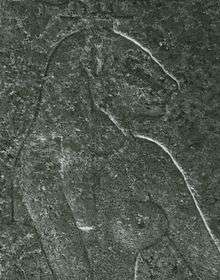Sebennytos
 Shown within Egypt | |
| Alternative name | Sebennytus |
|---|---|
| Location | Gharbia Governorate, Egypt |
| Coordinates | 30°58′00.0″N 31°15′00.0″E / 30.966667°N 31.250000°E |
| Type | Settlement |
| ṯb-nṯr in hieroglyphs |
|---|

Sebennytos or Sebennytus (Arabic: سمندود Samannūd, Coptic: ϫⲉⲙⲛⲟⲩϯ[1], Koine Greek: Σεβέννυτος, Ptol. iv. 5. § 50, Steph. B. s. v. or ἡ Σεβεννυτικὴ πόλις, Strabo xvii. p. 802, Egyptian: ṯb-nṯr, probably pronounced */ˌcabˈnaːcar/ in Old Egyptian, */ˌcəbˈnuːtə/ in Late Egyptian[2]), was an ancient city of Lower Egypt, located on the Damietta (Sebennytic) branch of the Nile in the Delta. Sebennytos was the capital of Lower Egypt's twelfth nome (the Sebennyte nome). Sebennytos was also the seat of the Thirtieth Dynasty of Egypt (380-343 BCE).[3][4][5]
Geography
Sebennytos lies nearly due east of Sais in the 31st parallel north. During the Thirtieth Dynasty and nearby, on the same banks of this branch of the Nile, was Behbeit El Hagar.[6]
Sebennytos was anciently a place of some importance, and standing on a peninsula, between a lake (λίμνη Σεβεννυτική, Lake Burullus) and the Nile, was favorably seated for trade and intercourse with Lower Egypt and Memphis. The neglect of the canals, however, and the elevation of the alluvial soil have nearly obliterated its site. [7]
History
Sebennytos is perhaps best known as the hometown of Manetho, a historian and chronicler from the Ptolemaic era, c. 3rd century BC. Sebennytos was also the hometown of Nectanebo II, and he was its last ruler.[8]
A temple dedicated to the local god Anhur, or Anhur-Shu, and his lioness goddess mate Mehit, once existed at this location but is now reduced to ruins. A fragment to where kings would have made offerings to Onuris and his wife, is on display at the Walters Art Museum.[9] The site is also known as part of the route of the Holy Family during their time in Egypt.[10]
In 1843, John Gardner Wilkinson described it as a place of some size, with the usual bazaars of the large towns of Egypt, and famous for its pottery, which are sent to Cairo.[11]
References
- ↑ https://st-takla.org/books/pauline-todary/coptic-language/egyptian.html
- ↑ Loprieno, Antonio (1995) Ancient Egyptian: A Linguistic Introduction, Cambridge: Cambridge University Press, ISBN 0-521-44384-9, p. 34
- ↑ Gray, Leon (2010). The New Cultural Atlas of Egypt. Marshall Cavendish. p. 143. ISBN 9780761478775. Retrieved 5 November 2016.
- ↑ Peck, Harry Thurston (1898). Harpers Dictionary of Classical Antiquities (1898). Harper and Brothers. Retrieved 5 November 2016.
- ↑ Cooper, William Ricketts (1876). An Archaic Dictionary: Biographical, Historical, and Mythological: From the Egyptian, Assyrian, and Etruscan Monuments and Papyri. S. Bagster and Sons. p. 496.
- ↑ Wilkinson, John Gardner (2013). Modern Egypt and Thebes. Cambridge University Press. p. 412. ISBN 978-1-108-06509-2.
- ↑ Champollion, Jean-François. l'Egypte, vol. ii. p. 191.
- ↑ Bill Manley, The Seventy Great Mysteries of Ancient Egypt" Thames & Hudson Ltd, 2003. p.101
- ↑ Watterson, Barbara (2003). Gods of Ancient Egypt. History Press. p. 41. ISBN 978-0-7524-9502-6.
- ↑ "The Holy Family at Meniet Samanoud". Tour Egypt. Archived from the original on 12 September 2016. Retrieved 6 November 2016.
- ↑ Wilkinson, John Gardner (1843). Modern Egypt and Thebes: Being a Description of Egypt, Including the Information Required for Travellers in that Country. John Murray. p. 432.
| Preceded by Mendes |
Capital of Egypt 380 – 332 BC |
Succeeded by Alexandria |